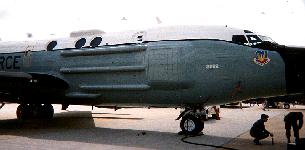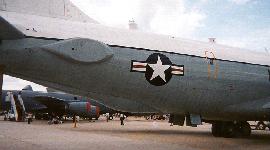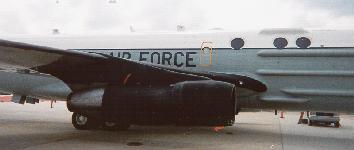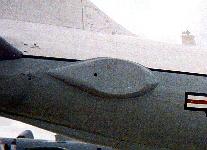|
|
|

The COBRA BALL is an Air Force airborne intelligence platform (RC-135) which carries infrared telescopes for tracking
ballistic-missile tests at long range. The COBRA BALL aircraft, operating out of Eielson AFB AK, allow the United
States to monitor every reentry vehicle flown from Russian test ranges, to determine the capabilities of each Russian
missile, new or old.
The Cobra Ball suite of Signals Intelligence (SIGINT) and Measurements and Signatures Intelligence (MASINT) sensor systems designed to exploit the enemy electromagnetic spectrum. The MASINT sensors are two linked electro-optical sensors -- the Real Time Optics System (RTOS) and the Large Aperture Tracker System (LATS). RTOS consists of an array of staring sensors encompassing a wide field of regard for target acquisition. LATS serves as an adjunct tracker. Due to its large aperture, it has significantly greater sensitivity and resolving power than the RTOS, but is otherwise similar. Connectivity includes JTIDS and TIBS data links.
Variants have been proposed for the operational detection of theater ballistic missile launches. In war, Cobra Ball could provide rapid recognition of TBM launches following cloud-break and horizon clearance. Within seconds of launch detection, estimates of launch point, intercept point, and impact point are available for transmission over a data link to theater C4I elements like AWACS, JSTARS, and the AOC. Estimates of increasing accuracy are transmitted during the course of the missile's flight until burnout has occurred.

E-Systems converted the COBRA EYE RC-135X (62-4128) into another COBRA BALL, which was slated for delivery during 1997, allowing the Air Force to have two aircraft constantly available for deployment. Previously, the Air Force operated two aircraft, but this resulted in a shortfall every three years when one of the aircraft underwent programmed depot maintenance at Raytheon/E-Systems in Greenville, TX. Two COBRA BALLs will constitute the primary assigned aircraft inventory, with the third in backup status receiving system upgrades. The backup status will rotate among the three aircraft as each plane undergoes depot work.

DARO program funds cover the development and acquisition of laser ranging and medium wave infrared (MWIR) sensors
for one COBRA BALL aircraft. This effort supports research and development of theater and national missile defense
systems and enhancement of COBRA BALL capabilities for support of scientific and technical intelligence collection
on foreign ballistic missile systems and treaty verfication. Contracts were awarded in 1997 to develop and integrate
laser ranger and MWIR sensors on one COBRA BALL aircraft to support testing at White Sands and Wallops Island Ranges.
Following successful tests at these ranges, the first aircraft operationally deployed world-wide, as an additional
system was procured for installation on the second COBRA BALL aircraft. Acquisition of the second system was accomplished
by the Air Force.
Textron Systems has developed the Medium Wave Infrared
Array (MIRA), an optical surveillance sensor system that offers near term migration across RC-135 systems. Technology
transfer of the optical systems in Cobra Ball RC-135 reconnaissance aircraft (including communications and satellite
fusion systems) to the Rivet Joint fleet, provides significantly enhanced capabilities for theater missile defense.
The Electro-Optical System for the Cobra Ball RC-135 surveillance aircraft includes long-range visible and infrared
surveillance sensors, long-range laser range systems and mission tested software. Textron Systems designs, develops,
manufactures, tests and maintains these operationally-proven surveillance systems. Textron Systems' RC-135 Electro-Optical
Systems were developed specifically for use by the U.S. Air Force. This advanced surveillance system is instrumental
in providing real-time actionable, reconnaissance data to theater commanders worldwide.
COBRA BALL Common Mission Architecture modifies three COBRA
BALL aircraft to a common RC-135 architecture which will include: procurement of equipment, modification of an
existing airframe, installation of equipment and flight test. Sensor systems will include two sided EO/IR radiometric
sensors, and spectral sensors (MTOS). Field of regard for the collection systems will be 120° centered off
the wings covering both sides of the aircraft. Onboard maintenance and calibration capability will be provided
(identical to RJ). Communications systems will be common with RJ, providing real time TIBS/JTIDS data to war fighters
and peace-time communications with command and control agencies. The data distribution system will be fiber optic
backbone enabling a high bandwidth communications for real time data fusion of onboard and offboard sensor data.
COBRA BALL is currently the sole source airborne provider of precise, high quality multiple intelligence data on
foreign ballistic/theater missile systems and their associated research and development complexes. COBRA BALLís
targets have traditionally been Russian ballistic missiles in support of treaty monitoring. Although still an active
collection target set, emphasis has moved to Rest-o-World collection activities. With this emerging role, additional
capabilities for baseline RSTA for ROW operations must be procured to give COBRA BALL a comparable collection capablility
against ROW targets. A continuing need exists for monitoring and exploitation of the proliferation of missiles
and other weapons of mass destruction in ROW target areas. The collection of this data is mandatory for the Intelligence
Preparation of the Battlefield (IPB) databases. Furthermore, COBRA BALL can provide unique missile alerting and
cueing capabilities during wartime conditions. This design complies with JASS and JSAF CRD requirements.
COBRA BALL Automated Mission Management gives the aircraft
Tactical Coordinator (TC) the software tools, and hardware interfaces, to external and internal data for real-time
decision making optimizing data collection and overall aircraft sensor management. This includes positioning the
aircraft for optimum collection, situational awareness displays, collection management software, real-time reporting
capabilities, and air-to-air and air-to-ground data link management for real-time data fusion. Advanced trajectory
software will estimate impact locations to higher precision. The system operator will be able to predict launch
areas based on expert systems technology. This will combine data fusion software, map and terrain (DTEDS) data,
and predictive modeling software to estimate TEL location based on time and geographical location. All data will
be available for broadcast over tactical data real-time. Increased awareness will provide increased productivity,
along with real-time reporting, over existing data tactical links (TIBS, JTIDS, and future IBS).
COBRA BALL All Weather Tracking Radar procures three modified
radar sensors, one per aircraft, for installation into COBRA BALL aircraft to track missiles and other targets.
This will allow detection and three dimensional (3D) tracking/position of targets (missiles, cruise missiles, and
aircraft) in all weather conditions. This will provide COBRA BALL with a stand-alone capability for Rest-of-World
(ROW) target areas and enhance its Theater Missile Defense (TMD) capabilities. A continuing need exists for monitoring
and exploitation of the proliferation of missiles and other weapons of mass destruction in ROW target areas. The
collection of this data is mandatory for the timely Intelligence Preparation of the Battlefield (IPB) databases.
The COBRA BALL airborne radar sensor will detect and track launches of ROW missile systems and other threats in
all weather conditions. The requirement was validated by DIA, Intelligence Community (IC) Staff, and Strategic
Reconnaissance Group (SRG) as stated in the 7 Dec 89 letter to AF/INXY, SRG Minutes of 14 Nov 89.
CFM-56 Re-engining completes re-engining of RC-135 aircraft
with CFM-56 engines, and modifies the airframes to support re-engining. The project decreases cost of ownership
and increases operational capability by installing new, fuel efficient engines. The upgrade also reduces maintenance
manpower and logistics costs; the new engine is more reliable than the current engine, and the engine is common
with the AMC KC-135 fleet. This project extends unrefueled range and time-on-station, and permits operations at
higher altitudes, increasing airborne sensor field of view and effectiveness. Increased altitude range provides
flexibility to airspace planners integrating aircraft into conjested airspace just behind the FEBA. The new engines
decrease dependency on tankers for air refueling, and provide a capability to takeoff on shorter runways at increased
gross weights. The project facilitates two-level maintenance concept reducing costs by 32%, and supports improved
aircraft environmental system prolonging sensitive sensor life. Failure to fund re-engining to completion will
leave a logistically split RC-135 fleet, equipped with two completely different engines. Increased cost of ownership
due to duplicate spares at each operating location. Current TF-33 engines will become more difficult and costly
to support requiring significant increases in future O&M costs (TF-33 parts no longer in production). The RC-135
fleet would lack commonality with re-engined KC-135 fleet, and the GAO validated $1.7B life cycle savings (total
RC-135 program) would not be realized if this project was not funded.
COBRA BALL Cockpit Modernization includes the COBRA BALL in
the Air Force PACER CRAG initiative to upgrade the C-135 fleet cockpit, and installs the GATM/FANS avionics required
to operate in the evolving civil air structure. PACER CRAG installs new compasses, radar, multi-function displays,
and global positioning system/flight management system. New fuel panel, Mode S IFF, TCAS, precision altimeters,
and DAMA compliant, 8.333 KHz channel radios are included in this upgrade. This project provides COBRA BALL aircraft
commonality with the C-135 fleet for training, logistics, and parts. The initative eliminated "vanishing vendor"
problems associated with diverging from the KC-135 avionics, and permits aircraft to comply with ICAO navigation
and communication standards to operate in the trans-oceanic and European portions of the commercial air structure.
Improves safety, reliability, and maintainability of aircraft. Absent this upgrade, aircraft will be denied access
to increasing portions of civil air space without proper navigation/communications equipment. Current avionics
systems will become unsupportable as KC-135 migrates to newer equipment. Commonality will be lost with the rest
of the C-135 fleet. Common parts supply base will not be available.
COBRA BALL Integrated Airborne Communications Operator/Data
Link Operator (ACO/DLO) integrates the ACO/DLO function into a modern, open architecture, networked workstation,
capable of controlling all communications assets. It will allow full access of all data links and their information
to all operators on the aircraft. TRAP, TIBS, JTIDS (Link-16), and future wideband communications systems, with
connectivity to national systems, will be available on the aircraft LAN. Operators will be able to choose which
data to display for situational awareness, sensor management, data fusion with internal sensor information, and
mission management/coordination with other sensors or collectors in real-time. The current ACO/DLO is unable to
effectively distribute on-board communications due to "older" personal computer-based equipment and displays,
no networking, and limited situation awareness. Communications are not currently connected to the aircraft LAN.
The new COBRA BALL Common Advisory Warning System (AWS) initiative
will provide a scaled down version of RIVET JOINT (RC-135V/W) AIA capability with 100% functional commonality.
Operators will have identical displays/functions to RIVET JOINT, minimizing operator training and currency requirements.
Collection capability will be scaled down from 12 operators on RIVET JOINT to five operators (including the ACO/DLO
position) required on the COBRA BALL aircraft. This scaling allows a reduced number of receive, demod, and record
channels. Automated Search and Geolocation functions along with a full assortment of PROFORMA processing will be
retained. The Common AWS will have full tactical data link providing interoperability. Processing of data products
will be done in the RIVET JOINT ground processing centers. Current COBRA BALL AWS, collection and DF capabilities
are inadequate to permit unassisted world-wide missions. High-threat areas may require COBRA BALL be accompanied
by an AWS capable aircraft (RIVET JOINT). Improves COBRA BALL capability to collect signals while monitoring foreign
missile events and range activities.





